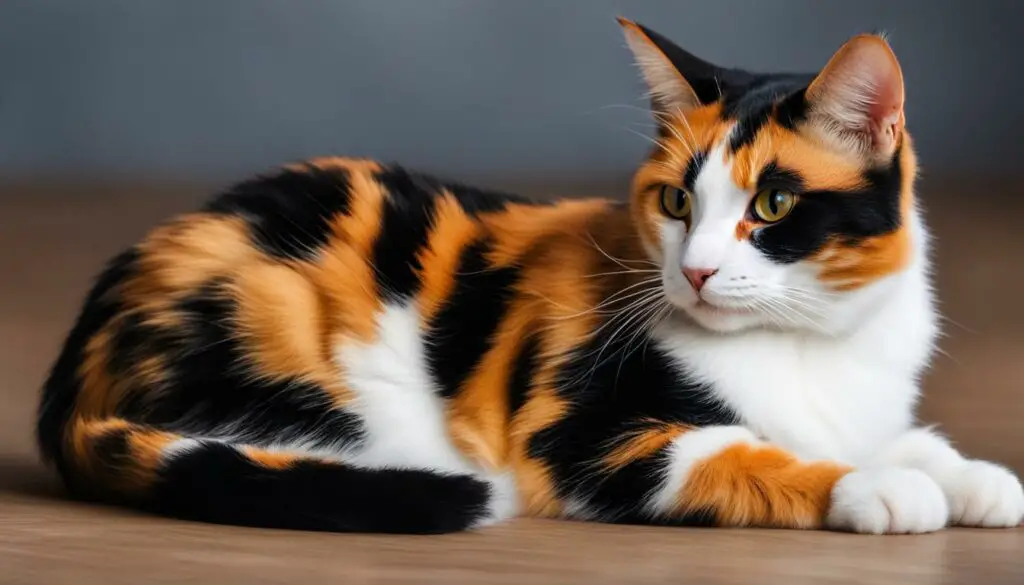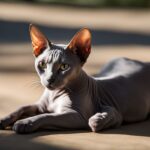As a cat lover, I am always fascinated by the diverse and captivating world of feline companions. Today, I want to introduce you to the enchanting beauty of the calico polydactyl cat. These unique creatures boast a distinctive coat pattern, a blend of vibrant colors that will surely capture your heart.
Calico cats, known for their tri-color coats, are a mesmerizing sight to behold. With hues of black, orange, and white, each calico cat’s coat tells a story of its own. But what makes these feline wonders even more special is their polydactyl trait, meaning they have extra toes. It’s like a secret little surprise hidden within their already fascinating appearance.
Throughout history, calico cats have held a special place in various cultures. Considered lucky charms, these cats bring good fortune and protection against the supernatural. It’s no wonder that Maryland even adopted the calico cat as its official state cat!
Key Takeaways:
- Calico cats have a distinctive tri-color coat pattern, usually black, orange, and white.
- They can be any domestic cat breed with this unique coat pattern.
- Calico cats often have the polydactyl trait, meaning they have extra toes.
- They are considered lucky charms in many cultures.
- Maryland has adopted the calico cat as its official state cat.
The Coat Pattern of Calico Cats
Calico cats have a unique coat pattern that sets them apart from other feline companions. Their tri-color fur is a visual delight, displaying a combination of black, orange, and white. However, it’s important to note that calico cats are not a specific breed but can be found in various domestic cat breeds.
The variation in colors within the calico coat pattern is fascinating. In addition to the classic black, orange, and white, calico cats can also exhibit shades of cream, blue-black, brown, and reddish-orange. This assortment of colors adds to their charm and makes each calico cat truly one-of-a-kind.
Calico cats may also possess the unique polydactyl trait, meaning they have extra toes. This adds another interesting element to their appearance. While not all calico cats are polydactyl, the combination of their distinctive coat pattern and extra toes makes them even more special.
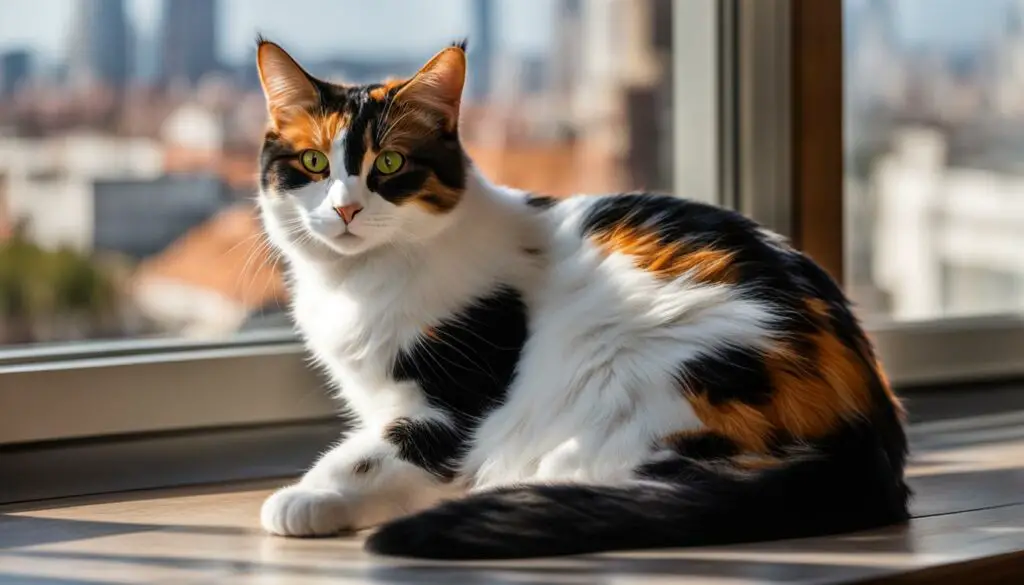
The Coat Pattern of Calico Cats
| Fur Colors | Description |
|---|---|
| Black, Orange, and White | The classic calico coat pattern that most people associate with calico cats. |
| Cream | Lighter shades of orange, creating a softer, more subdued appearance. |
| Blue-Black | Dark shades of grayish-blue combined with black and white. |
| Brown | Rich, earthy tones that add depth and warmth to the calico fur. |
| Reddish-Orange | Deeper shades of orange with a reddish undertone, creating a vibrant look. |
The Origins of Calico Cats
Calico cats, with their beautiful tri-color coat pattern, have a rich and intriguing history that spans across different cultures and continents. The unique origins of calico cats can be traced back to ancient times, with possible roots in the land of the pharaohs, Egypt. Studies suggest that the orange mutant gene found in calicos may have originated in Egypt and spread through shipping trade routes along the Mediterranean Sea.
These remarkable felines were believed to have been brought to Europe during the shipping trade era, where their distinctive coat pattern caught the attention of many. The genetic diversity found in calico cats is thought to be a result of crossbreeding between different domestic cat breeds, further adding to their charm and allure.
It’s worth noting that calico cats sometimes possess an extra special trait – polydactylism, or having extra toes. This fascinating genetic variation can also be found in some calico cats, adding to their unique and captivating appeal. Polydactyl calico kittens, with their adorable little paws, are indeed a sight to behold.
| Interesting Facts about Calico Cats |
|---|
| Calico Cats in Egypt: Thought to have originated in ancient Egypt, where they were considered sacred and associated with good luck. |
| Spread through Trade Routes: Calico cats are believed to have been transported across trade routes, leading to their presence in Europe and other parts of the world. |
| Genetic Diversity: The unique coat patterns seen in calico cats are a result of genetic diversity from crossbreeding between different domestic cat breeds. |
| Polydactyl Calico Kittens: Some calico cats exhibit the polydactyl trait, meaning they have extra toes, which only adds to their extraordinary charm. |
Through their origins and genetic diversity, calico cats have become beloved companions and adored members of households around the world. Their distinct coat patterns and the possibility of extra toes make them truly special and sought after by cat enthusiasts.
The Unique Genetics of Calico Cats
Calico cats have fascinated scientists and cat lovers alike due to their unique genetics. The distinctive coat patterns seen in calico cats are a result of the X-chromosome inactivation process, which occurs in female cats. This process allows for random activation of color genes on different chromosomes, leading to the striking combination of colors seen in their fur.
Unlike male cats, which have one X and one Y chromosome, female cats have two X chromosomes. During early embryonic development, one of the X chromosomes in each cell is randomly inactivated. This means that some cells express one set of color genes, while others express a different set. As a result, the coat of a calico cat can display patches of black, orange, and white.
Calico cats are a result of genetic mosaicism, where different cells in the body have different genetic makeup due to the X-chromosome inactivation process. This unique genetic phenomenon contributes to the beautiful and intricate coat patterns of calico cats.
It’s important to note that male calico cats are extremely rare. In order for a male cat to have a calico coat, it would require having an extra X chromosome, resulting in a genetic abnormality. This abnormality is known as Klinefelter’s Syndrome, and it affects male cats’ fertility and overall health. Male calico cats may also have a shorter lifespan compared to their female counterparts.
The Personality of Calico Cats
Calico cats are known not only for their unique coat colors but also for their charming and engaging personalities. Here are some traits that make calico cats truly special:
1. Intelligence and Curiosity
Calico cats are often described as intelligent and curious. They have a natural curiosity about their surroundings and love to explore new environments. Their intelligence enables them to quickly learn new tricks or games, making them enjoyable companions for interactive play.
2. Sweet and Affectionate
Calico cats are also known for their sweet and affectionate nature. They often seek attention and enjoy being petted or cuddled. They form strong bonds with their human companions and can be fiercely loyal. Calico cats have a knack for sensing their human’s emotions and providing comfort when needed.
3. Quirky and Sassy
One of the most endearing aspects of calico cats is their quirky and sassy personalities. They have a unique sense of independence and can be quite feisty at times. Calico cats are not afraid to express their opinions and will often make their presence known. Their sassy nature adds a touch of entertainment to their already captivating personalities.
Overall, calico cats are loving, intelligent, and full of character. Their playful and affectionate nature makes them wonderful companions for families with children and other pets. Whether they are playing, cuddling, or simply lounging around, calico cats bring joy and charm to any household.
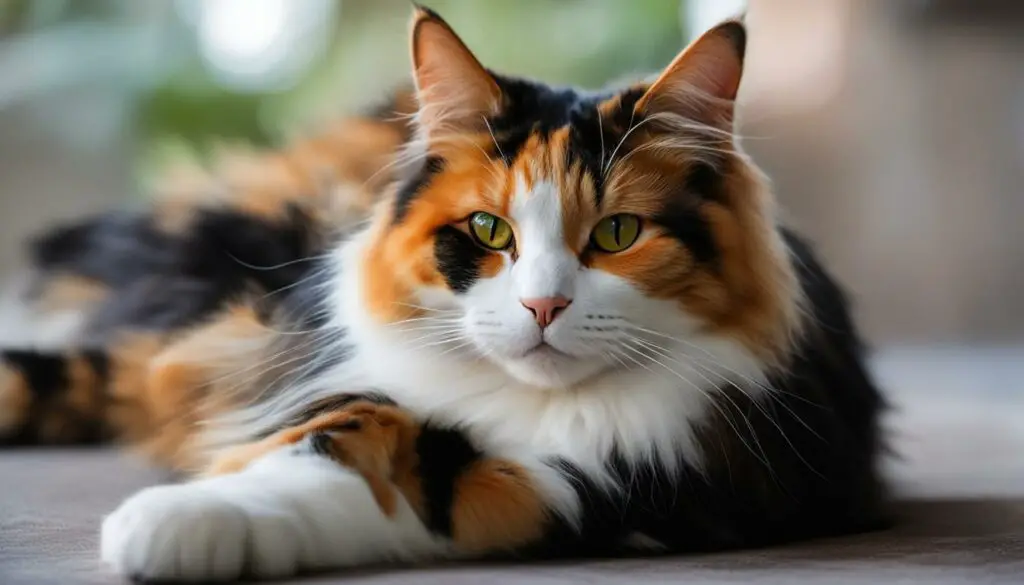
The Cultural Significance of Calico Cats
Calico cats hold a special place in many cultures around the world. They are often considered symbols of good luck and protection against negative forces. In Japan, calico cats are known as maneki-neko or “beckoning cats” and are believed to bring wealth and prosperity to their owners. These iconic cat figurines with one paw raised in a beckoning gesture can be found in shops, homes, and businesses throughout Japan. Calico cats are also associated with good fortune in the United States, where they are sometimes referred to as “money cats.”
In addition to their good luck charm status, calico cats have played significant roles in folklore and superstitions. In Japanese folklore, it is believed that calico cats have the power to ward off evil spirits and protect homes from harm. They are also associated with protection against harsh storms. In Irish folklore, calico cats are said to possess magical healing powers. Rubbing the tail of a calico cat was believed to cure warts. These beliefs add to the overall allure and charm of these unique felines.
The cultural significance of calico cats is not limited to superstitions and folklore. In fact, some states in the United States have recognized the importance of calico cats by adopting them as official state representatives. Maryland, for example, declared the calico cat as its official state cat in 2001. This decision was influenced by the similarity between the colors of the calico cat’s fur and the state bird and insect. It’s a testament to the widespread adoration and recognition of calico cats in various parts of the world.
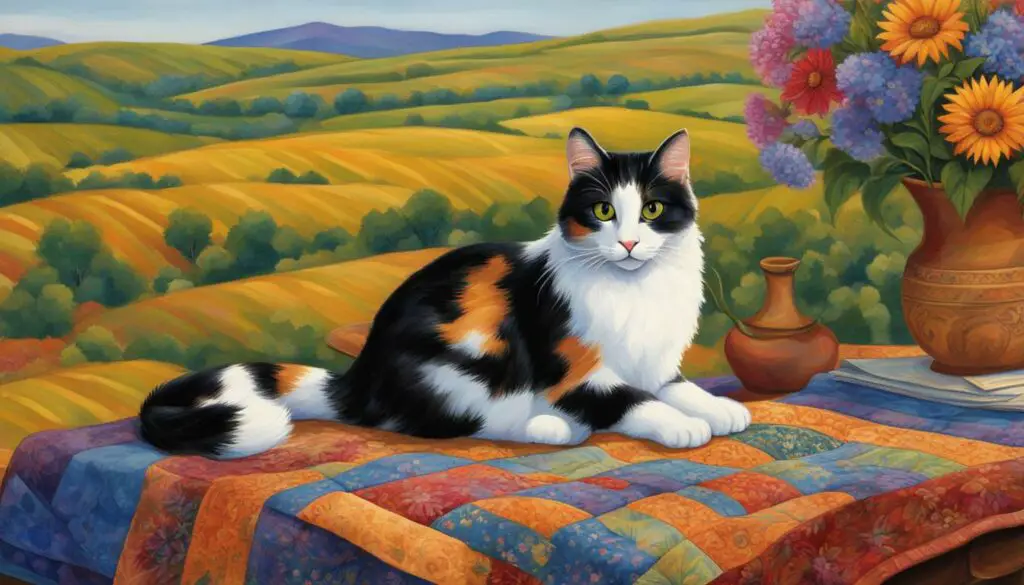
The Cultural Significance at a Glance:
- Calico cats are considered symbols of good luck and protection.
- In Japan, calico cats are known as maneki-neko or “beckoning cats” and are believed to bring wealth and prosperity.
- Calico cats are associated with protection against evil spirits and storms in Japanese folklore.
- In Irish folklore, calico cats were believed to possess magical healing powers, capable of curing warts.
- Calico cats have been recognized as official state representatives, such as in Maryland.
The rich cultural significance of calico cats adds to their allure and mystique. Whether as symbols of good luck, protectors against evil, or official representatives of states, these unique felines have captured the hearts and imaginations of people around the world.
Calico Cats as State Representatives
Calico cats have not only captured the hearts of cat lovers around the world but have also been recognized as official state representatives in certain states. These unique feline beauties have become a symbol of pride and identity for these regions.
Maryland: The Calico Cat
In 2001, Maryland adopted the calico cat as its official state cat. The vibrant colors of the calico cat’s coat resemble those of the Baltimore oriole bird and the Baltimore checkerspot butterfly, both of which are also symbols of the state. This recognition further solidifies the calico cat’s special place in the hearts of Maryland residents.
Maine: The Maine Coon
While calico cats may not hold the official title in Maine, the state has chosen another feline companion as its representative. The Maine Coon, known for its striking looks and friendly demeanor, has been designated as Maine’s official cat. This majestic breed, often associated with the state’s ruggedness and independence, perfectly embodies the spirit of Maine.
Massachusetts: The Tabby Cat
Tabby cats, with their distinctive striped patterns, have been chosen as the official state cat of Massachusetts. These beloved felines are recognized for their playfulness, intelligence, and adaptability. Massachusetts residents take pride in their tabby cats, knowing that they represent the state’s vibrant and diverse community.
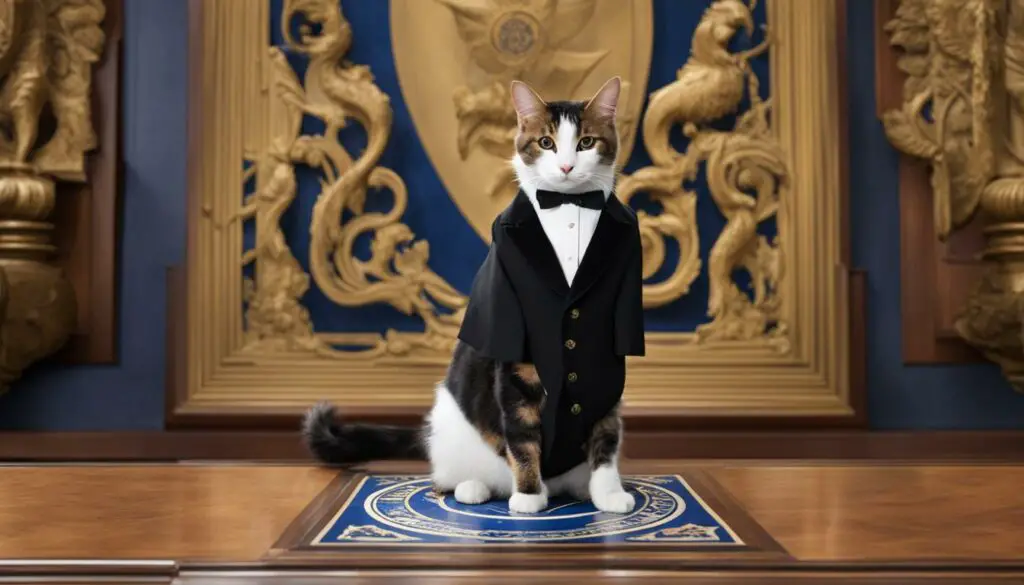
Calico cats hold a special place not only in homes but also as official representatives of certain states. Maryland, Maine, and Massachusetts have all chosen these unique and beautiful feline companions to symbolize their pride, heritage, and love for cats. Whether it’s the vibrant colors of the calico, the majestic presence of the Maine Coon, or the playful nature of the tabby, these state cats bring joy and warmth to the hearts of residents and visitors alike.
Calico Cats and Their Unique Appearance
Calico cats are known for their unique and captivating appearance. Their distinctive coat patterns, characterized by patches of orange, black, and white, make them stand out from other feline companions. However, not all calico cats have the same coloring. Some calico cats have what is known as a dilute calico coat.
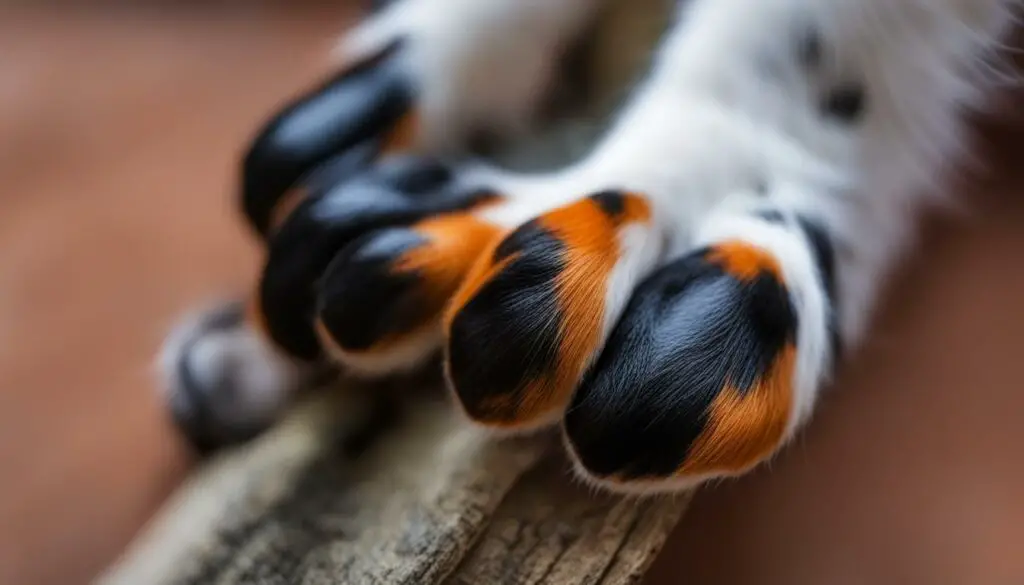
A dilute calico has primarily white fur with patches of lighter color in shades of blue-gray to cream. These softer hues give dilute calico cats an ethereal and almost pastel-like appearance, adding to their overall charm. The diluted colors create a beautiful contrast with the white patches, creating a visually appealing coat that sets them apart from other calico cats.
It’s important to note that the appearance of calico cats can vary, even among cats of the same breed. Each calico cat’s coat pattern is unique, making them truly one-of-a-kind companions. Their striking appearance is often a topic of conversation and admiration among cat enthusiasts and even casual observers.
In summary, calico cats, with their unmistakable coat patterns, including dilute calico variations, are a true feast for the eyes. Their colorful and eye-catching appearances make them standout companions, captivating the hearts of those lucky enough to have them in their lives.
Calico Cats and Their Genetics
Calico cats have always captured the fascination of cat lovers with their unique coat patterns and vibrant colors. But have you ever wondered about the genetics behind their eye-catching appearance? Let’s delve into the world of calico cat genetics and unravel the secrets behind their mesmerizing fur colors.
The genetics of calico cats is a complex and intriguing subject. Coat color in cats is determined by genes located on the X chromosome. Female calico cats, with two X chromosomes, undergo a fascinating process called X-chromosome inactivation. This process leads to the activation of different color genes on different chromosomes, resulting in the beautiful mosaic of colors seen in calico cats.
Each individual patch of fur on a calico cat is a result of the random inactivation and activation of genes. The combination of black, orange, and white patches creates the remarkable tri-color pattern that defines calico cats. No two calico cats are exactly alike, making each one a truly unique work of art.
The Genetic Lottery of Calico Coat Colors
The genetics behind calico coat colors can be likened to a genetic lottery. The random inactivation of X chromosomes means that calico cat offspring inherit a diverse range of coat colors from their parents. This genetic lottery produces an array of stunning fur colors and patterns, giving calico cats their distinctive and captivating appearance.
| Coat Color | Genetic Explanation |
|---|---|
| Black | The gene responsible for black fur is activated. |
| Orange | The gene responsible for orange fur is activated. |
| White | The gene responsible for white fur is activated. |
“The genetics behind calico cats create a beautiful tapestry of colors, showcasing the intricate workings of nature’s palette.”
It’s important to note that the genetics of calico cats also contribute to their rarity. Male calico cats are extremely rare, occurring in approximately 1 in 3,000 calico cats. This rarity is due to the specific genetic makeup required for a male cat to express the calico coat pattern. Male calico cats typically have genetic abnormalities, such as Klinefelter’s Syndrome, which can lead to health issues and reduced lifespan.
Calico cats continue to captivate us with their stunning coat patterns and unique genetics. Their exquisite fur colors serve as a reminder of the intricate and awe-inspiring workings of nature. Whether they are considered good luck charms or beloved companions, calico cats bring a touch of magic into our lives.
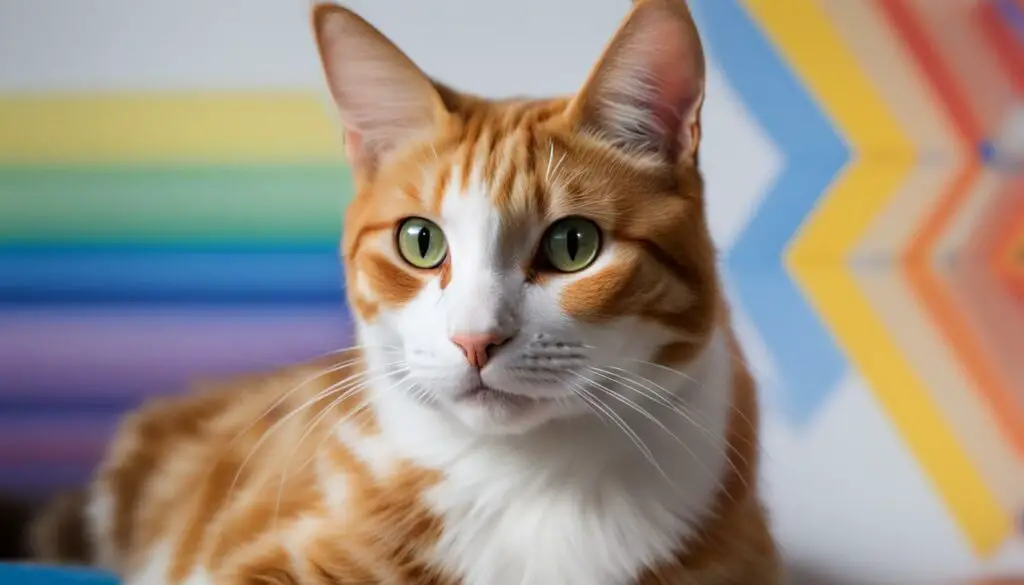
Health and Lifespan of Calico Cats
When it comes to the health and lifespan of calico cats, there are a few important factors to consider. Female calico cats, like cats with other coat patterns, have an average lifespan of 12 to 16 years. Providing them with proper care, including a nutritious diet, regular exercise, and routine veterinary check-ups, can help ensure a healthy and long life.
However, it’s worth noting that male calico cats are much rarer and often have genetic abnormalities that can impact their health and lifespan. Due to the unique genetic makeup required for a male cat to express the calico coat pattern, male calicos are estimated to be only 1 in 3,000 calico cats. These genetic abnormalities, such as Klinefelter’s Syndrome (XXY genes), can lead to various health issues and reduced lifespan.
Despite these challenges, with proper care and attention, male calico cats can still lead fulfilling lives. Regular veterinary check-ups, early detection of any health issues, and a loving home environment can greatly contribute to their overall well-being.
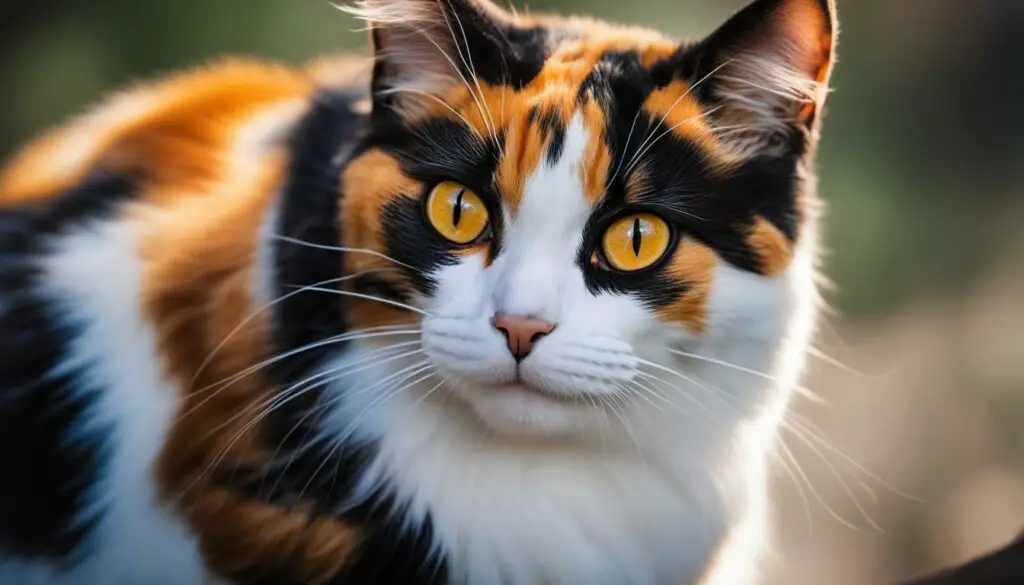
Common Health Issues in Calico Cats
Like all cats, calico cats are prone to certain health issues. While not exclusive to calico cats, these are some of the common health concerns to be aware of:
- Urinary Tract Issues: Calico cats, especially females, are more susceptible to urinary tract infections and bladder stones.
- Obesity: Calico cats can be prone to weight gain if not provided with a balanced diet and regular exercise. Obesity can lead to various health problems, such as diabetes and joint issues.
- Cancer: There may be a higher incidence of certain types of cancer in calico cats, although the exact reasons are still unknown. Regular check-ups and early detection are crucial for managing and treating any potential cancerous growths.
Providing the Best Care for Calico Cats
To ensure the health and well-being of your calico cat, it’s important to provide them with the best possible care. This includes:
- Feeding a balanced diet that is appropriate for their age and activity level.
- Keeping them physically active with regular playtime and exercise.
- Providing regular veterinary check-ups and vaccinations.
- Maintaining a clean and safe living environment.
- Giving them plenty of love, attention, and mental stimulation.
Summary
Female calico cats have an average lifespan of 12 to 16 years, similar to other cats. Male calico cats, due to their rarity and genetic abnormalities, may have shorter lifespans and various health issues. However, with proper care, including a nutritious diet, regular veterinary check-ups, and a loving home environment, calico cats can live long and fulfilling lives. It’s important to be aware of common health issues and provide the best possible care to ensure their overall well-being.
The Rarity of Male Calico Cats
Male calico cats are an extremely rare phenomenon, accounting for only about one in every 3,000 calico cats. This uniqueness stems from the genetic makeup required for a male cat to express the calico coat pattern. Unlike female calico cats, which have two X chromosomes, male cats have one X and one Y chromosome. The calico coat pattern is the result of specific genetic combinations, specifically the random inactivation of color genes on different X chromosomes. Due to the presence of the Y chromosome, male cats cannot have the same genetic makeup as female calico cats, making the appearance of male calico cats exceedingly rare.
The rarity of male calico cats is not the only factor that sets them apart. Male calico cats often suffer from genetic abnormalities, such as Klinefelter’s Syndrome, which can result in various health issues. These health problems can potentially reduce their lifespan compared to other cats. However, with proper care, attention, and regular veterinary visits, male calico cats can still lead fulfilling lives and provide companionship to their owners.
It is important to appreciate the uniqueness of male calico cats and ensure their well-being. Despite their rarity and potential health issues, these special felines deserve the same love and care as any other cat. By understanding their genetic makeup and providing them with the necessary support, male calico cats can thrive and bring joy to their owners’ lives.

Male Calico Cat Rarity and Health
The rarity of male calico cats and the potential health concerns associated with their unique genetics make them intriguing and special creatures in the feline world. While their appearance may be a rarity, it serves as a reminder of the fascinating genetic diversity that exists within the animal kingdom.
Calico Cats vs. Tortoiseshell and Tabby Cats
Calico cats, tortoiseshell cats, and tabby cats are all unique in their coat colors and patterns. While they may share some similarities, there are distinct differences that set them apart from each other.
Calico Cats
Calico cats have a tri-color coat pattern consisting of black, orange, and white patches. The white color can make up a significant portion of their fur, creating a striking contrast against the darker colors. Calico cats are known for their vibrant and varied coat patterns, with no two calicos looking exactly the same.
Tortoiseshell Cats
Tortoiseshell cats, also known as “torties,” have a coat pattern that consists of marbled orange and black colors. Unlike calico cats, tortoiseshell cats do not have white patches in their fur. The colors are intertwined, creating a unique mosaic-like pattern of orange and black throughout their coat.
Tabby Cats
Tabby cats have their own distinctive coat patterns, with prominent stripes and patches of ginger and black. Unlike calico and tortoiseshell cats, tabby cats can have a wide range of coat colors, including gray, brown, and even silver. Tabby cats are known for their beautiful markings and can come in various tabby patterns, such as mackerel, classic, spotted, or ticked.
While calico, tortoiseshell, and tabby cats all have unique coat patterns, it’s important to remember that these patterns are not specific to any particular breed. They can be found in various domestic cat breeds, adding to the diversity and charm of the feline world.
| Calico Cats | Tortoiseshell Cats | Tabby Cats |
|---|---|---|
| Tri-color coat pattern: black, orange, and white patches | Marbled orange and black coat pattern | Prominent stripes and patches of ginger and black |
| Vibrant and varied coat patterns | Colors intertwined, creating a mosaic-like pattern | Wide range of coat colors and tabby patterns |
| No white patches in the fur | No white patches in the fur | No specific color requirements |
Conclusion
In conclusion, calico cats are truly fascinating with their unique charm and distinctive coat patterns. These beautiful felines can be found in various domestic cat breeds, and their tri-color coats, typically consisting of black, orange, and white, make them stand out in the feline world. The white patches can be anywhere from 25% to 75% of their fur, creating a stunning and eye-catching appearance.
Calico cats have a rich history, with possible origins in Egypt and a spread through shipping trade routes. They are almost always female, and male calico cats are incredibly rare due to genetic abnormalities. These luck-filled creatures are considered fortunate in many cultures, with Maryland even adopting them as their official state cat.
Not only are calico cats visually appealing, but they also have delightful personalities. They are often described as sweet, affectionate, and intelligent. Their playful and friendly nature makes them wonderful companions for both children and other pets. Calico cats are truly a joy to have around and can bring a touch of quirkiness to any household.
Overall, calico cats are not only visually stunning but also carry cultural significance and have a captivating history. They are a symbol of good luck and charm in many cultures and have even been recognized as state representatives. So, if you have the privilege of sharing your home with a calico cat, consider yourself fortunate to have such a unique and delightful companion.
FAQ
What is a calico cat?
A calico cat is any domestic cat breed with a tri-color coat, usually black, orange, and white. The white coloring can make up 25-75% of their fur.
Where did calico cats originate?
The exact origin of calico cats is uncertain, but they are believed to have originated in Egypt and spread through shipping trade routes in Europe and Northern Africa.
Why are calico cats almost always female?
Calico cats are almost always female due to the unique genetics behind their coat patterns. Male calico cats are rare and usually have genetic abnormalities.
What is the personality of calico cats like?
Calico cats are generally described as sweet, affectionate, intelligent, and friendly to children and other pets. They have quirky and sassy personalities.
Are calico cats considered lucky charms?
Yes, calico cats are considered lucky charms in many cultures, including being adopted as the official state cat of Maryland.
What is the difference between calico cats, tortoiseshell cats, and tabby cats?
Calico cats have a tri-color coat pattern, while tortoiseshell cats typically have marbled orange and black coats. Tabby cats have distinct tabby stripes and prominent ginger and black patches.
Are male calico cats rare?
Yes, male calico cats are exceptionally rare, estimated to be only 1 in 3,000 calico cats. They often have genetic abnormalities and health issues.
How long do calico cats live?
Female calico cats have an average lifespan of 12 to 16 years, similar to cats with other coat patterns. Male calico cats may have shorter lifespans and various health issues.
What makes calico cats unique?
Calico cats have a unique coat pattern due to the X-chromosome inactivation process in female cats, which allows for random activation of color genes on different chromosomes.
Source Links
- https://sparklekitty.com/all-you-need-to-know-about-the-beautiful-calico-cat/
- https://www.thesprucepets.com/calico-cats-photo-gallery-4031810
- https://cats.com/calico-cats

